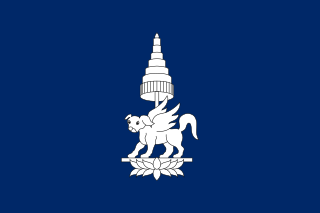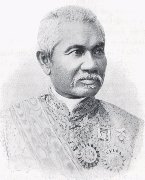Related Research Articles

Evidence of modern human presence in the northern and central highlands of Indochina, which constitute the territories of the modern Laotian nation-state, dates back to the Lower Paleolithic. These earliest human migrants are Australo-Melanesians—associated with the Hoabinhian culture—and have populated the highlands and the interior, less accessible regions of Laos and all of Southeast Asia to this day. The subsequent Austroasiatic and Austronesian marine migration waves affected landlocked Laos only marginally, and direct Chinese and Indian cultural contact had a greater impact on the country.

Chao Anouvong, or regnal name Xaiya Setthathirath V, , led the Lao rebellion (1826–28) against Siam as the last monarch of the Kingdom of Vientiane. Anouvong succeeded the throne in 1805 upon the death of his brother, Chao Inthavong, Xaiya Setthathirath IV, who had succeeded their father, Ong Bun or Phrachao Siribounyasan Xaiya Setthathirath III. Anou was known by his father's regnal number until recently discovered records disclosed that his father and brother had the same regnal name.

Phra Bat Somdet Phra Nangklao Chaoyuhua, personal name Thap, also styled Rama III, was the third king of Siam from the Chakri dynasty, ruling from 21 July 1824 to 2 April 1851.

Phra Bat Somdet Phra Phutthayotfa Chulalok Maharat, personal name Thongduang (ทองด้วง), also known as Rama I, was the founder of the Rattanakosin Kingdom and the first King of Siam from the reigning Chakri dynasty. His full title in Thai is Phra Bat Somdet Phra Paramoruracha Maha Chakri Boromanat Phra Phutthayotfa Chulalok. He ascended the throne in 1782, following the deposition of King Taksin of Thonburi. He was also celebrated as the founder of Rattanakosin as the new capital of the reunited kingdom.
Souligna Vongsa was the king of Lan Xang whose reign is considered the golden age of Laos. He ascended to the throne in 1637.

Pōmare I was the unifier and first king of Tahiti and founder of the Pōmare dynasty and the Kingdom of Tahiti between 1788 and 1791. He abdicated in 1791 but remained in power as the guardian regent during the minority of his successor Pōmare II from 1791 until 1803. He is best known in the western world for being the ruler of Tahiti during the mutiny on the Bounty in 1789.

The Duchy of Orléanais is a former province of France, which was created during the Renaissance by merging four former counties and towns. However after the French Revolution, the province was dissolved in 1791 and succeeded by five départments.

The French protectorate of Laos was a French protectorate in Southeast Asia of what is today Laos between 1893 and 1953—with a brief interregnum as a Japanese puppet state in 1945—which constituted part of French Indochina. It was established over the Siamese vassal, the Kingdom of Luang Phrabang, following the Franco-Siamese crisis of 1893. It was integrated into French Indochina and in the following years further Siamese vassals, the Principality of Phuan and Kingdom of Champasak, were annexed into it in 1899 and 1904, respectively.

The Kingdom of Champasak or Bassac, (1713–1904) was a Lao kingdom under Nokasad, a grandson of King Sourigna Vongsa, the last king of Lan Xang and son-in-law of the Cambodian King Chey Chettha IV. Bassac and the neighboring principalities of Attapeu and Stung Treng emerged as power centers under what was later to be described as the Mandala Southeast Asian political model.
Fay Na was king of the southern Laotian Kingdom of Champasak from 1791 to 1811. He was promoted by King Rama I of Siam for the noble title "Phra Wichaiyaratkhattiyawongsa".
No Muong was king of the southern Laotian Kingdom of Champasak in 1811. His reign is sometimes confused or combined with that of his son Chao Nou.
Huy was prince-governor of the Siamese vassal Kingdom of Champasak in southern Laos from 1828 to 1840.

Kham Souk was king of the southern Laotian Kingdom of Champasak from 1863 to 1899. He was preceded by Kham Nay, who reigned from 1856 to 1858, and a period of interregnum from 1858 to 1863.

The Lao Rebellion of 1826–1828 was an attempt by King Anouvong of the Kingdom of Vientiane to end the suzerainty of Siam and recreate the former kingdom of Lan Xang. In January 1827 the Lao armies of the kingdoms of Vientiane and Champasak moved south and west across the Khorat Plateau, advancing as far as Saraburi, just three days march from the Siamese capital of Bangkok. The Siamese mounted a counterattack to the north and east, forcing the Lao forces to retreat and ultimately taking the capital of Vientiane. Anouvong failed in both his attempt to resist Siamese encroachment, and to check the further political fragmentation among the Lao. The kingdom of Vientiane was abolished, its population was forcibly moved to Siam, and its former territories fell under the direct control of Siamese provincial administration. The kingdoms of Champasak and Lan Na were drawn more closely into the Siamese administrative system. The kingdom of Luang Prabang was weakened but allowed the most regional autonomy. In its expansion into the Lao states, Siam overextended itself. The rebellion was a direct cause of the Siamese-Vietnamese wars in the 1830s and 1840s. The slave raids and forced population transfers conducted by Siam led to a demographic disparity between the areas that would ultimately become Thailand and Laos, and facilitated the "civilizing mission" of the French into Lao areas during the latter half of the nineteenth century.

The Kingdom of Vientiane was formed in 1707 as a result of the split of the Kingdom of Lan Xang. The kingdom was a Burmese vassal from 1765 to 1779. It then became a Siamese vassal until 1828 when it was annexed by Siam.

The Kingdom of Tahiti or the Tahitian Kingdom was a Polynesian monarchy founded by paramount chief Pōmare I, who, with the aid of British missionaries and traders, and European weaponry, unified the islands of Tahiti, Moʻorea, Teti‘aroa, and Mehetiʻa. The kingdom eventually annexed the Tuamotus, and the Austral Islands.

Hotepibre Qemau Siharnedjheritef was an Egyptian pharaoh of the 13th Dynasty during the Second Intermediate Period.
Chao Raja Putra Sadet Chaofa JayaNyô, born in Vientiane in the early nineteenth century and died in 1828, was crown prince of the Kingdom of Vientiane and Uparaja (Vice-king) of the Kingdom of Champasak. In Vietnamese records, he was called Hạt Xà Bút (曷蛇筆).

Lao–Siamese War or the Siamese Invasion of Laos (1778–1779) is the military conflict between Thonburi Kingdom of Siam and the Lao kingdoms of Vientiane and Champasak. The war resulted in all three Lao kingdoms of Luang Phrabang, Vientiane and Champasak becoming Siamese tributary vassal kingdoms under Siamese suzerainty and domination in Thonburi and the subsequent Rattanakosin Period.
References
- 1 2 3 Baird, Ian G (2017). "Champassak royal sacred Buddha images, power and political geography". South East Asia Research. 25 (4): 359–378. ISSN 0967-828X.
- 1 2 Bangperng, Kiattisak (2020). "Champasak: Dhammayuttika Nikaya and the Maintenance of Power of the Thai State (Buddhist Decade 2390- 2450)". International Journal of Innovation, Creativity and Change. 13 (12): 1158–1174.